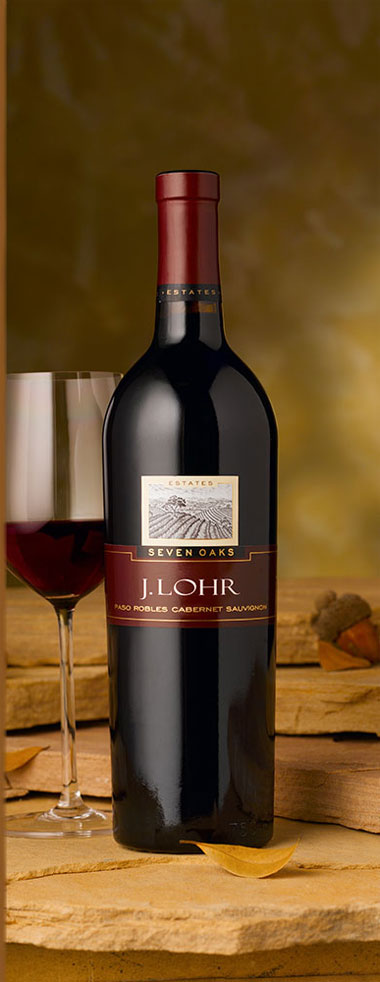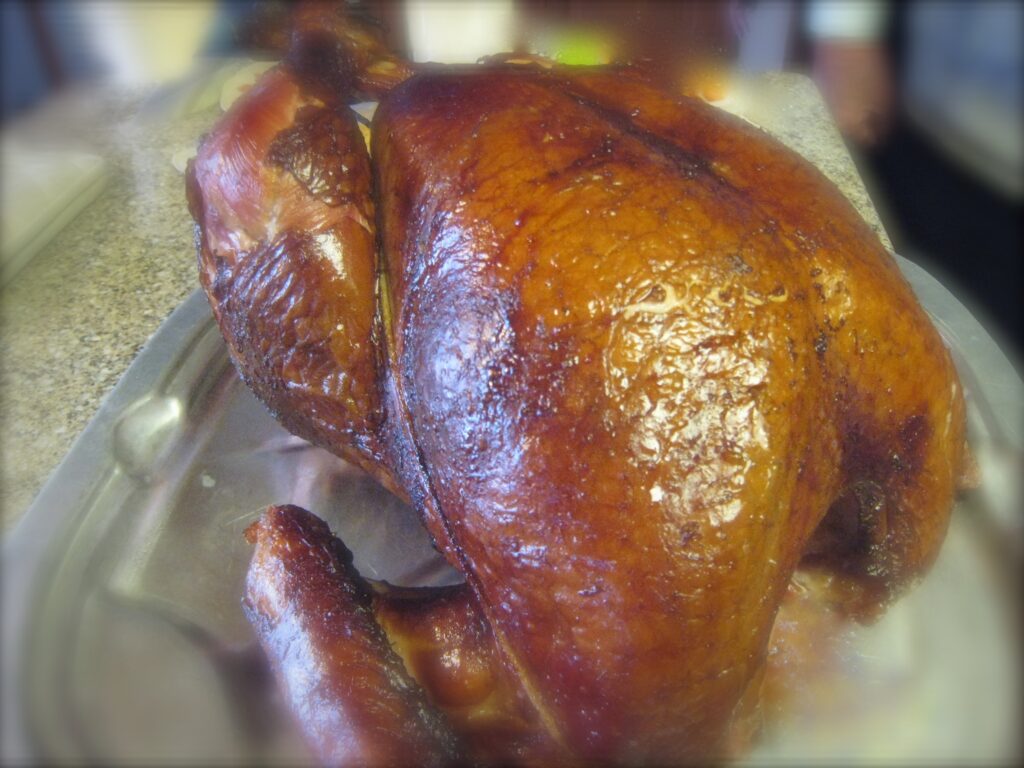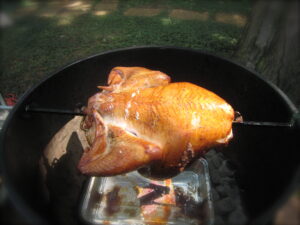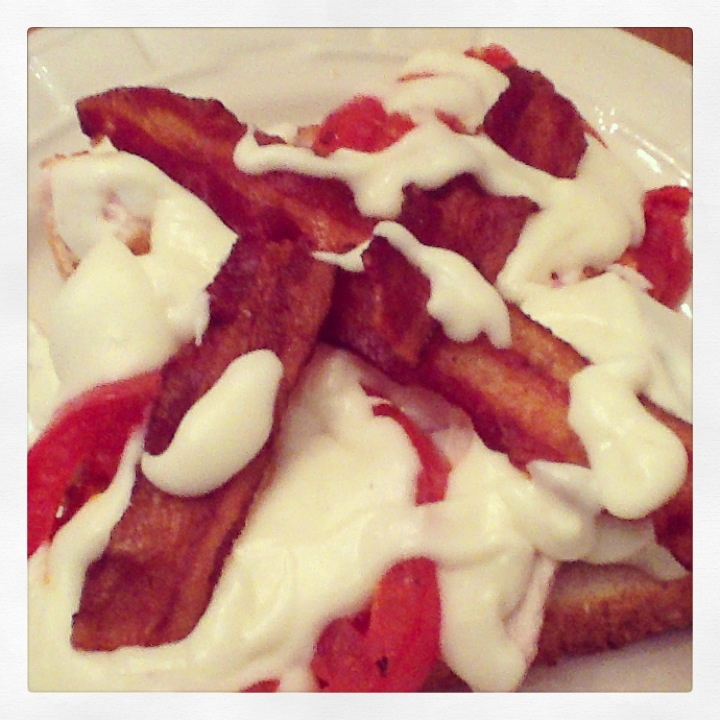We had a lovely day.
Meal info to come. Maybe. 🙂
This is the third year that I’ve cooked our Thanksgiving turkey on the Weber Kettle. It was the first time that I’ve done it without using the rotisserie attachment, and it turned out beautifully.
We dry brined the bird Wednesday evening with a mixture of kosher salt, cracked black pepper, Turbinado sugar, garlic powder and Herbs de Provence. I stuffed the turkey with onions and Mandarin oranges, then sprayed it with olive oil before placing it on the preheated grill over a drip pan containing a bottle of inexpensive Cabernet Sauvignon. Hickory and Cherry chunks provided the smoke.
I started it breast side down, and flipped it over about an hour into cooking. The grill was running more than 400 F to start, and eventually leveled off to around 300. For a 13 pound bird, I’d estimated that it would take around 2 1/2 hours at these temperatures, and that was right on the money. The lowest temp in the breast was around 160 when we brought the turkey in and covered it with a foil tent to rest.
I strained the pan drippings and used them to make a simple gravy, starting with a roux and adding seasonings and some stock.
We served the J. Lohr Cab Sauv with the meal, and it was delicious, but I think I’d go with a Pinot Noir next time.
 When planning a wine pairing for Thanksgiving Dinner, I’ve always heard of the ABC rule: anything but Cabernet Sauvignon. This year, I’m breaking the rule.
When planning a wine pairing for Thanksgiving Dinner, I’ve always heard of the ABC rule: anything but Cabernet Sauvignon. This year, I’m breaking the rule.
The issue is that turkey is not thought to contain enough fat or flavor to balance against the tannins of the Cab Sauv. By smoking the turkey on the Weber kettle grill, we ought to have the flavor part of the equation covered. I also plan to make gravy from the drippings, which should add some richness at table.
The wine will be a 2010 Seven Oaks from J. Lohr, splash decanted to soften the tannins a bit, a trick I learned to tame Malbec that grips so hard it pulls your tonsils out.
We’ll report back later in the week.

My apologies for not posting this earlier. I’m sure that you’ve been waiting impatiently to hear how our Thanksgiving Turkey turned out on the rotisserie.
I did make some adjustments from the trial run, using a fresh turkey, taking care to properly dry brine and stuff the bird, using hickory wood for smoke, and icing the breast prior to cooking to help keep it rarer. After the charcoal was nearly gone under the rotisserie, I moved the turkey to the gas grill to finish cooking so that I could use a probe thermometer to monitor doneness more easily.
In short, it turned out really well. Here are just a couple of observations.
1) I’m not sure that I’d spend the money on a fresh bird again. This one turned out better than the trial run bird, but I’m not sure that it can be attributed to a fresh bird. I expected it to be “out of this world” better than any turkey I’d ever tasted, and it just wasn’t. Nothing wrong with it, but nothing notable in texture or taste that is distinctive to it not having been frozen. If a frozen bird is good enough for Alton Brown, I’ll save myself $60 next year.
2) My wife thought this was the best turkey she’d ever tasted. My father-in-law thought that the dark meat was a little dry. I thought that the doneness and texture was perfect, but it was missing a savoriness for me. This may be because I’m used to turkeys that come “pre-basted.” We’ll see if next time the combination of pre-basting for flavor and my own dry brining for additional flavor and texture will strike the right balance. The worst thing you can say about a Butterball or other pre-basted bird is that you’re essentially paying for brine. As cheap as supermaket birds are, I won’t object to that.
Part of the issue may be that I’m comparing the rotisserie turkey to rotisserie chicken, which always seems to turn out mouth-watering delicious. I want the turkey to be like that. Guess we’ll just have to keep working at it.
Or maybe I should cook chickens for Thanksgiving next year.

In preparation for this year’s Thanksgiving Dinner, I roasted a whole turkey on the rotisserie over the weekend. In some ways, this is one of the most challenging things to cook, since it’s difficult to get the dark meat done enough without overcooking the breast.
Overall, it turned out just “alright.” Having done a marvelous job with a turkey breast awhile back, and a series of awesome whole chickens, I expected this to be over-the-top delicious. It certainly wasn’t bad, especially for a first attempt, but there are several things I would do differently next time.
1) Use a fresh turkey. The frozen turkey I cooked was “pre-basted.” This sounds like it would be a good thing, but it’s actually not. The addition of a brine solution prior to freezing actually changes the texture and taste of the bird in a way that is inferior to proper dry brining. For Thanksgiving, I’ll look for a locally raised fresh turkey.
2) Take more care with the seasoning and brining. Because the turkey was pre-basted, I didn’t want to overdo my own seasoning, particularly the salt. I limited my efforts to a little kosher salt, black pepper and herbs de provence rubbed on the skin a couple hours prior to roasting. I also didn’t stuff the cavity, thinking that this was a “dry run” anyway, and the additional aromatics wouldn’t add much. Next time, I’ll take care to properly dry brine a fresh turkey the day before, and to add plenty of citrus, onions, garlic, etc. to the cavity before cooking. My wife usually works some olive oil under the skin just prior to putting the bird in the oven as well. Although the rotisserie helps to keep food moist through self-basting, we may try her trick as well.
3) Choose your smoke wisely. I’ve been on a Cherry wood kick lately, loving the subtly sweet flavor it added to pork ribs and beef roast. In the case of turkey, I think a bolder smoke flavor would have been nice. I’ll likely use Apple, Hickory, or a mixture of the two next time.
4) I need an ice pack. One of the tricks Mike Vrobel suggests when roasting turkey on the rotisserie is to put an ice pack on the breast while it comes to room temperature before going on the grill. This has the effect of increasing the cooking time for the white meat, and allowing the legs and thighs to get up to well done without overcooking the breast. It’s listed as an “optional” step in his instructions, but I’ll definitely use it next time. The breast turned out alright, but the dark meat could have cooked just a bit longer to achieve “fall off the bone” tenderness.
A friend of mine sensed my disappointment in describing the meal as “alright” and commented that every meal doesn’t have to be a masterpiece. I suppose that’s right, although as much time and effort as goes into this particular dish, I’ll want to get it perfect next time. I think the adjustments mentioned above will make it worthy of our Thanksgiving table.
For Christmas of 2012, my wife gave me a rotisserie attachment for my Weber Kettle Grill. I’d wanted one for a long time, though the $150 price tag seemed a little too extravagant. The notion of roasting food on a spit, like the honeymoon scene in It’s A Wonderful Life, has always seemed romantic to me, and once the rotisserie arrived I could hardly wait to fire up the coals and roast something amazing with it. There was one problem. I had absolutely no idea how to cook with it.
I mean, of course I knew that the spit goes through what you’re cooking and you turn the motor on and it spins – but I didn’t know anything else about the process or preparing food for the rotisserie, how to set up the grill, how long to cook things, etc.
Luckily, in addition to a book on rotisserie cooking that was also under our tree for me, I did a little online search and found Mike Vrobel’s book Rotisserie Grilling and his site, Dad Cooks Dinner. I’ve come to think of Mike as the authoritative source on the subject, and his are among the first resources I turn to when I am researching something I haven’t cooked before. His dry-brined rotisserie chicken was the very first thing I cooked on my kettle rotisserie, and it’s still one of my favorite dishes.
One of the next things I tried was a turkey breast, and it was so delicious that my wife decided I should be responsible for our Thanksgiving turkey this year. Since a whole turkey involves a lot of special setup and variables, we figured it would require a test run, so that’s what I’m doing this coming Sunday.
Vrobel’s step-by-step advice on the matter will obviously be the game plan for the day, beginning with his demonstration of how to truss and spit the bird. Since I’ve had good luck with chickens and with the turkey breast, I’m expecting the whole turkey to be wonderful, but there is one further thing I have to learn between now and Sunday – how to carve.
I know. One might expect that at 56 years of age a guy would know how to carve a turkey, but through the years we always seemed to travel to someone else’s home for Thanksgiving dinner, and over the last decade or so, my wife’s father was always with us to carve. Honestly, I’ve been a bit timid in the face of the pressure. So I never learned. In fact, even for more pedestrian fare, I tend to shove off the carving duties onto my wife. Lack of confidence is an awful thing.
Finally I am determined to do it despite my insecurities, and (thankfully) I ran across this video from the New York Times a few years ago, and happened to have logged the URL. They make it look simple.
Wish me luck!
 For Sunday Dinner each week we do our best to prepare a special meal and usually invite my wife’s parents to join us. After seeing a recent Throwdown episode where Bobby Flay traveled to Louisville, I decided to try my hand at Kentucky Hot Browns this past weekend, and to cook as much of the dish as possible on the grill.
For Sunday Dinner each week we do our best to prepare a special meal and usually invite my wife’s parents to join us. After seeing a recent Throwdown episode where Bobby Flay traveled to Louisville, I decided to try my hand at Kentucky Hot Browns this past weekend, and to cook as much of the dish as possible on the grill.
If you’re unfamiliar with the Hot Brown, it’s an open-faced turkey and bacon sandwich with Mornay Sauce that originated at the Brown Hotel in Louisville. It’s since taken its place alongside such regional delights gone large as The Manhattan, The Monte Cristo, The Reuben and The Horseshoe which are all now legendary sandwiches around the world. In fact, Flay notes that it’s one of his own most favorite sandwiches.
Here’s how I prepared our version.
I started with a seven-and-a-half-pound turkey breast, cooking it on the rotisserie atop my Weber Kettle grill, using skills and methods I learned from the authoritative book on the subject, Rotisserie Grilling by Mike Vrobel. I would highly recommend that you read the book, but you can get the short course on rotisserie turkey breast over on his Website.
I used Mike’s basic process and recipe, then added some Herbs de Provence to the bird before grilling and a cup of Hickory chips to the coals. The smell of the smoke and charcoal, and the sound of drippings vaporizing as they hit the drip pan were marvelous as I enjoyed my Sunday morning coffee.
Once the breast was off the spit and resting, I warmed up the Weber Genesis gas grill to cook some thick cut bacon. I’d never tried it on the grill before, but it worked out perfectly. I used a large foil roasting pan that we had left over from last Thanksgiving, arranging the bacon across the bottom, and cooking it over medium-high indirect heat (side burners on medium-high, middle burner off, and the pan in the middle of the grill). I watched the bacon pretty carefully, turning it every few minutes with tongs until it was done.
Now it was time for the cheese sauce. One of our favorite pasta dishes is Giada De Laurentis’ Baked Rigatoni with Béchamel Sauce, and I decided to borrow the sauce from that recipe. It’s actually a Mornay sauce, since you add grated cheese to the Béchamel. In this case, I used a wedge of Fontinella that happened to be on hand. My wife helped to tend the sauce while I grilled some thick tomato slices (a little olive oil, pepper and kosher salt) and warmed up some Texas Toast on the Genesis.
Since I’m terrible at carving — I know, it’s a character flaw — she also sliced some nice thick cuts of the turkey breast, and we were ready to assemble our Hot Browns. We split a piece of toast diagonally for each plate, heaped the turkey on top along with two of the tomato slices, covered it all with the Mornay Sauce and then added a couple of the crisp bacon rashers criss-crossing over the whole mess.
The result was one of the most delicious sandwiches I’ve ever tasted. The turkey was done to perfection. I had checked the temperature a little early while it was grilling, and that was fortunate because it had already hit 160 degrees, which is where you want it for the peak of juicy tenderness. The cheese sauce was incredibly rich and thick, the tomatoes added a bright counterpoint to the other savory flavors, and the bacon…oh, my.
We served these with some green beans and onions that were also cooked on the grill (in a foil packet with some of the bacon grease) and a wonderful salad with my wife’s family recipe vinaigrette.
There are a couple of things that I might do differently the next time I make Hot Browns (which will likely be standard fare in our home on Derby Day in the years to come). Firstly, a little cayenne in the cheese sauce might have been nice. Secondly, I think the whole dish could benefit from just a few moments under the broiler after assembly to get the cheese bubbling and bring all the flavors together. I reckon that these two additions ought to take the recipe about as far as it can go, as it was awfully good without them.
The only downside to the whole experience is that my wife liked the turkey so much, she asked again when I’m going to practice with a whole turkey on the rotisserie in anticipation of this year’s Thanksgiving Dinner. Help! Mike!
Copyright © 2025 Noebie Digital Media · Powered by WordPress and the Genesis Framework